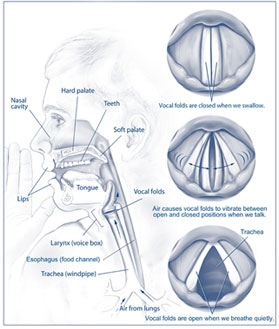On this Page:
- Voice Disorders
- Speech Disorders
- Language Disorders
- Identifying Voice, Speech, and Language Disorders
- Implications of Voice, Speech, and Language Disorders
Voice Disorders
Voice (or vocalization) is generated by airflow from the lungs as the vocal folds in the larynx are brought close together. When air is pushed past the vocal folds with enough pressure, the vocal folds vibrate, producing a voice.
From birth, voice plays an important role. Newborns interact with their caregivers, vocally producing a variety of coos and cries to signal their needs and feelings. As a baby grows, his or her expressive repertoire expands.
Throughout life, our voices play a major role in conveying emotion and expressing personality, mood, and health. If the larynx is diseased or malfunctioning, a voice disorder may develop, resulting in difficulty with communication. Because of the interplay between breathing, speaking, and swallowing, many researchers in this field also study laryngeal functions and swallowing disorders.
The causes of voice disorders include neurological injury, trauma, environmental toxins, disease, and vocal misuse. Voice disorders may also be symptoms of psychiatric conditions, e.g., selective mutism.
Speech Disorders
Speech is the precisely coordinated muscle actions of the tongue, lips, jaw, and vocal tract (or speech articulators), which together shape air flow to produce the sounds of one's language. As a baby learns to control and coordinate the vocal tract, early speech sounds, babbling, vocal play, and words gradually unfold.
Some children have difficulty mastering speech sound production. Disorders of speech sound acquisition occur most often in the preschool years, both in children who are developing normally and in children who have developmental disabilities. Most early childhood speech disorders have no known cause.
Another category of speech disorder is stuttering, which is characterized by a disruption in fluency/flow of speech. Most children outgrow stuttering. About 1 percent or less of adults stutter.
Onset of a speech disorder is not limited to childhood. Speech disorders can occur throughout the lifespan, and are generally associated with diseases or trauma.
Language Disorders
Language is a shared system for communicating and exchanging knowledge, feelings, thoughts, and beliefs. Language involves sounds, signs, gestures, and/or spoken or written words that convey meanings within a group or community. Within the first few years of life, most children easily move from single words to word combinations, and eventually to fully formed sentences.
Language disorders can affect both children and adults. One common childhood language disorder, Specific Language Impairment, appears to occur in the absence of any other developmental problems. Other language disorders in children may be associated with hearing impairment, autism, mental retardation, or congenital or acquired disorders of brain development.
An adult who has had a stroke may experience a language disorder known as aphasia. Other disorders that may be associated with language impairment include head injury, dementia, or brain tumors.
Identifying Voice, Speech, and Language Disorders
A voice, speech, or language disorder may initially be suspected or identified by family members, physicians, educators, or by the individual experiencing difficulty in communication. Speech-language pathologists and other specialists evaluate and diagnose such disorders through a thorough patient history, a clinical exam and assessment, and comparison of performance to standardized norms or norm-reference tools.
Voice assessment usually includes perceptual judgments made by the professional, as well as instrumental measures. Loudness, pitch, and voice quality are assessed with rating scales. Other aspects of voice assessment require objective measures using instrumentation, such as imaging and endoscopy.
To assess speech, health professionals inventory a patient's speech sounds and measure speaking rate and rhythm. These assessments are carried out for the diagnosis of motor speech disorders and/or stuttering.
Language assessment may involve formalized questionnaires; direct observation; and testing of vocabulary, understanding, the production of words and sentences, and the use of language in social situations.
Given the diversity of the U.S. population, interpretation of findings from voice, speech, and language assessment measures must take into account the native language of the speaker.
Implications of Voice, Speech, and Language Disorders
To function in our society, we must be able to communicate effectively. Despite valuable scientific and technological advances, many aspects of modern life remain profoundly difficult for an individual with a voice, speech, or language disorder. These disorders often affect a person's emotional and social life, and can compromise educational and job opportunities.
The cost of these disorders in quality of life and human potential is substantial--whether the individual is a child who stutters as he struggles to speak up in class, a lawyer with an adult-onset voice disorder, or a post-stroke individual laboring to communicate verbally. As the population ages and as survival odds improve for medically fragile infants and individuals who have sustained injury or acquired disease, the number of people with voice, speech, and language disorders will likely continue to increase.


